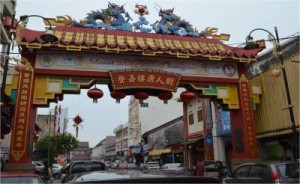MCA Terengganu chief Datuk Toh Chin Yaw, 56, proudly calls himself a “local boy” of Kuala Terengganu, Terengganu.
He talks fondly about the city, and is currently working on rejuvenating it, especially the historic Kampung Cina area – Terengganu’s China Town.
“I was born and bred here,” said Toh. “So this place will always be very special to me.”
For the modern tourist, Kampung Cina appears to be nothing more than a street with two rows of old shops. But once upon a time, it was a bustling port and fishing village, a place where the ancestors of many of its current inhabitants first arrived from Southern China.
According to Toh, many businesses started to move out of Kampung Cina as Kuala Terengganu started developing, which is why Toh decided to focus on rejuvenating the entire area once he was elected as an assemblyman in 2004.
“If no one makes an effort, the essence of this town will fade away,” he said.
Toh was speaking to the BRATs after a chance encounter outside Kampung Cina’s 216-year-old Ho Ann Kiong temple, where he was launching another one of his many efforts to promote Kuala Terengganu.
Astro Classic Golden Melody 2009 finalist Jimmy Liew had been invited to perform his new song, I Love Terengganu, on the street by the famous temple, accompanied by line dancers from MCA Warga Emas Kuala Terengganu.
The line dancers had choreographed a special routine to go with the song, and Toh, having roped in all the BRATs, danced along as well.
Toh had also persuaded Liew to shoot the music video for his song at famous tourist attractions around Terengganu.
“We want to encourage locals to come back to Kampung Cina by making it feel more lively, friendly and welcoming,” he said.
“We have done many other projects. We beautified the waterfront, paved the walkways, and we organise activities during all the major cultural and religious festivals. A lot more tourists have been coming since then.”
Toh added that Kampung Cina is unique because even though it is dubbed ‘China Town’, Malaysians of various different races frequent the area and run businesses there.
“We organise celebrations during all the major cultural and religious festivals, and everyone joins in,” said Toh. “During Chinese New Year, for example, the whole main street was closed for two days for lion dances and stage performances.”
Apart from the activities, the revitalisation project has also worked a lot on improving the infrastructure of the area.
All the shops in Kampung Cina were repainted, with the shop owners given free paint and their own choice of colours. All the sidewalks were paved with concrete and decorative lights were installed.
Unsafe houses on stilts behind Kampung Cina were torn do
wn and a canal was built, improving the general outlook of the back façade and creating a proper sewage system.
A narrow alley, once inaccessible, was reconstructed and decorated to become “Turtle Alley”, a tourist attraction and a pathway to the waterfront running parallel with Kampung Cina’s main street.
Information boards, mosaics and other decorative pieces were installed on the alley walls to raise awareness about endangered turtle species.
And come September, a ‘Revitalisation Workshop’ will be held for a week for architecture students from around the world
.
“The students will be from Malaysia, Singapore, Australia, and Europe, and they will brainstorm on how to redesign the front of the buildings,” revealed Lorenz Law, secretary of the Kampung Cina Community Association, which works closely with Toh on the revitalisation project.
“The recent state of the town is dull compared to the olden days when it was active and business was good”, added Law. “What we are doing now is motivating the people to be involved in bringing back those good days.”


Tell us what you think!